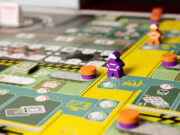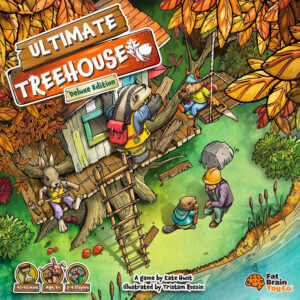 At Gen Con this year, one of my games to check out was Ultimate Treehouse from Fat Brain Toy Company. For some reason, the treehouse theme really draws me in, with Best Treehouse Ever still getting plenty of table time despite being close to a decade old.
At Gen Con this year, one of my games to check out was Ultimate Treehouse from Fat Brain Toy Company. For some reason, the treehouse theme really draws me in, with Best Treehouse Ever still getting plenty of table time despite being close to a decade old.
Ultimate Treehouse is a gateway/family-weight game for 2-4 players that takes about 45 to 60 minutes to play. It’s suitable for players ages 8+
Gameplay Overview:
The goal in Ultimate Treehouse is to earn the most victory points for your treehouse at the end of the game. Each round starts with a weather card being drawn, which may affect the costs of things you build that round. The upcoming weather card for next round is always face up, so you can plan ahead as well.

On your turn, you first draw an Action card. Then, you can optionally play an action card from your hand and/or build one or more elements into your treehouse. Each element has a specific place on your tree it needs to go, as well as a cost to build it (in resources) and the number of victory points it will score you.
Some elements will increase in the points they provide by building multiple copies of them. For example, if you build 3 tree swings, you are getting 11 points instead of just 3 points for one of them.
Then the next player takes their turn. Rounds go by in this manner until the weather deck is depleted. The player with the most points wins.

Game Experience:
This is the first board game from Fat Brain Toy Company, which until now, primarily made toys. You can tell that the company has solid manufacturing experience because the game looks fantastic. The player boards are neoprene mats wonderfully illustrated by Tristam Rossin. And I really enjoyed how when you build something in your tree, it overlays nicely to see your treehouse come to life. The resource tokens are also thick, screen printed wood. Overall, the production values in this game are outstanding.

For the gameplay, you can tell that Ultimate Treehouse is aimed at new gamers who are just dipping their toes into the modern board game world. The rulebook starts out by talking about game lingo (victory points, rounds, resources, etc…), as well as some mechanics of the game. I could see this being really helpful for someone whose only experience with gaming is mass-market titles. The rulebook also contains a QR code for a learn to play video, however, it wasn’t working at the time of this review.
The core gameplay loop of Ultimate Treehouse is pretty easy to understand. Play a card from your hand to gain resources to buy a tile from the market, and place it on your tree in the specific spot that matches the art. Repeat until the game ends when you total up your points. I feel like new players should have an easy time understanding the gameplay and it does work well as an introduction to modern gaming.
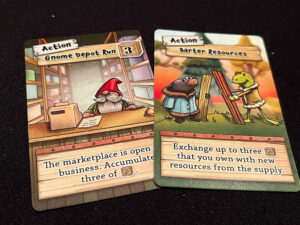
That being said, there are a few issues with Ultimate Treehouse that really hold it back from me recommending it to gamers and new players. The biggest problem I have with the game is that the action cards, one of the main mechanisms in the game, just don’t seem to be balanced. For example, there are cards in the action deck called “Gnome Depot Run” (props for the awesome pun) that will give you anywhere from 2-4 resources of your choice (depending on the card). The 4-value card is clearly one of the best in the game because you can take whatever you want.
There are also resource-specific cards, such as Metal Works, where you can gain three metal. Since I can only ever play one card on my turn, there would never be a reason I’d rather play Metal Works over Gnome Depot Run. There is also a card called Barter Resrouces that lets you exchange 3 resources you own with any 3 from the supply. Compare that to a level 3 Gnome Depot Run, where you just gain 3 resources that you want. One of those cards is objectively better than the other, and I can’t really figure out a reason how that’s balanced.
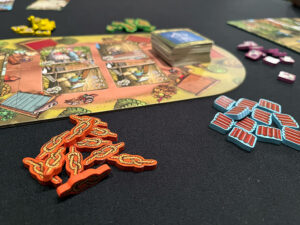
To compound that, the game also tosses in some “take that” cards that do things like steal cards from your opponent, or even stop them completely from building the next round. In most of our games, we didn’t really even want to use these cards, as the take that element feels really out of place in this game. This is especially true because resources are so critical to the game, and it only lasts about 10 rounds or so. Eventually, you’ll get to a round where you can’t build anything, and all you can do on your turn is play a card, which no one seemed to enjoy. In a game where resource management is so tight, losing a round of building can be critical.
Personally, I think the game would have been better served with some automatic resource gains each round, and let the action cards all act like bonuses. Being able to take 2 resources at the start of your turn, and then play a card to either gain 1-2 more, or adjust the market somehow would have been an easy way to balance out the gameplay. As it stands now, drawing certain cards that are just better than others gives some players a clear advantage.
The other issue we ran into was figuring out where to place things on our tree. Some people might enjoy matching up the art as a bit of a scavenger hunt, but it kind of bogged our games down. Trying to figure out, “ok this tile goes here” was more of a pain than anything. We finally realized that the inside cover of the rulebook had a guide for placement, but passing that around the table was kind of annoying. Either numbers on the cards or a player aid card would have gone a long way to helping speed this part up.
Final Thoughts:
Ultimate Treehouse feels like a game that’s just almost there. This game really could have definitely used some more play testing and development. It might also be growing pains from both a first-time game designer and a publisher who’s just getting into the modern gaming space. But I think with more outside playtesting (and even blind playtesting) many of these issues would have come up and could have been addressed.
However, as it is, it’s a little tough to recommend a game where one of the core mechanics of the game is just really unbalanced. Which is too bad, because that game absolutely looks beautiful. That being said, it’s not a bad game, just one I’m probably not going to reach for very often, even when new gamers are at my table.
Final Score: 2.5 Stars – Great production values and nice-looking art, but it’s held back by gameplay that definitely needed more development time.
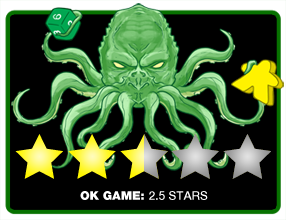 Hits:
Hits:
• Fantastic production values
• Easy-to-learn rules
Misses:
• Action cards are unbalanced
• Hunting for where to place the cards is annoying
• Take that mechanics feel out of place






